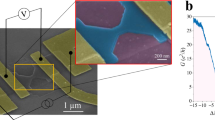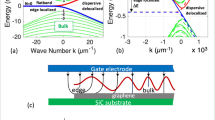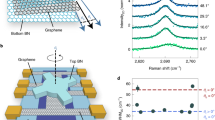Abstract
Two-dimensional materials such as graphene allow direct access to the entirety of atoms constituting the crystal. While this makes shaping by lithography particularly attractive as a tool for band structure engineering through quantum confinement effects, edge disorder and contamination have so far limited progress towards experimental realization. Here, we define a superlattice in graphene encapsulated in hexagonal boron nitride, by etching an array of holes through the heterostructure with minimum feature sizes of 12–15 nm. We observe a magnetotransport regime that is distinctly different from the characteristic Landau fan of graphene, with a sizeable bandgap that can be tuned by a magnetic field. The measurements are accurately described by transport simulations and analytical calculations. Finally, we observe strong indications that the lithographically engineered band structure at the main Dirac point is cloned to a satellite peak that appears due to moiré interactions between the graphene and the encapsulating material.
This is a preview of subscription content, access via your institution
Access options
Access Nature and 54 other Nature Portfolio journals
Get Nature+, our best-value online-access subscription
$29.99 / 30 days
cancel any time
Subscribe to this journal
Receive 12 print issues and online access
$259.00 per year
only $21.58 per issue
Buy this article
- Purchase on Springer Link
- Instant access to full article PDF
Prices may be subject to local taxes which are calculated during checkout





Similar content being viewed by others
Data availability
The data that support the plots within this paper and other findings of this study are available from the corresponding author upon reasonable request.
References
Dean, C. et al. Hofstadter’s butterfly and the fractal quantum Hall effect in moiré superlattices. Nature 497, 598–602 (2013).
Ponomarenko, L. et al. Cloning of Dirac fermions in graphene superlattices. Nature 497, 594–597 (2013).
Hunt, B. et al. Massive Dirac fermions and Hofstadter butterfly in a van der Waals heterostructure. Science 340, 1427–1430 (2013).
Forsythe, C. et al. Band structure engineering of 2D materials using patterned dielectric superlattices. Nat. Nanotechnol. 13, 566–571 (2018).
Caridad, J. M., Connaughton, S., Ott, C., Weber, H. B. & Krstić, V. An electrical analogy to Mie scattering. Nat. Commun. 7, 12894 (2016).
Stampfer, C. et al. Energy gaps in etched graphene nanoribbons. Phys. Rev. Lett. 102, 056403 (2009).
Banszerus, L. et al. Ballistic transport exceeding 28 μm in CVD grown graphene. Nano Lett. 16, 1387–1391 (2016).
Wang, L. et al. One-dimensional electrical contact to a two-dimensional material. Science 342, 614–617 (2013).
Zeng, Y. et al. High quality magnetotransport in graphene using the edge-free Corbino geometry. Preprint at https://arxiv.org/abs/1805.04904 (2018).
Polshyn, H. et al. Quantitative transport measurements of fractional quantum Hall energy gaps in edgeless graphene devices. Preprint at https://arxiv.org/abs/1805.04199 (2018).
Barone, V., Hod, O. & Scuseria, G. E. Electronic structure and stability of semiconducting graphene nanoribbons. Nano Lett. 6, 2748–2754 (2006).
Sandner, A. et al. Ballistic transport in graphene antidot lattices. Nano Lett. 15, 8402–8406 (2015).
Yagi, R. et al. Ballistic transport in graphene antidot lattices. Phys. Rev. B 92, 195406 (2015).
Han, M. Y., Brant, J. C. & Kim, P. Electron transport in disordered graphene nanoribbons. Phys. Rev. Lett. 104, 056801 (2010).
Fang, T., Konar, A., Xing, H. & Jena, D. Mobility in semiconducting graphene nanoribbons: phonon, impurity, and edge roughness scattering. Phys. Rev. B 78, 205403 (2008).
Yang, Y. & Murali, R. Impact of size effect on graphene nanoribbon transport. IEEE Electron. Dev. Lett. 31, 237–239 (2010).
Bang, K. et al. Effect of ribbon width on electrical transport properties of graphene nanoribbons. Nano Converg. 5, 7 (2018).
Kim, M., Safron, N. S., Han, E., Arnold, M. S. & Gopalan, P. Fabrication and characterization of large-area, semiconducting nanoperforated graphene materials. Nano Lett. 10, 1125–1131 (2010).
Mackenzie, D. M. A. et al. Graphene antidot lattice transport measurements. Int. J. Nanotechnol. 14, 226–234 (2017).
Mackenzie, D. M. A. et al. Batch fabrication of nanopatterned graphene devices via nanoimprint lithography. Appl. Phys. Lett. 111, 193103 (2017).
Wang, M. et al. CVD growth of large area smooth-edged graphene nanomesh by nanosphere lithography. Sci. Rep. 3, 1238 (2013).
Peters, E., Giesbers, A., Zeitler, U., Burghard, M. & Kern, K. Valley-polarized massive charge carriers in gapped graphene. Phys. Rev. B 87, 201403 (2013).
Pan, J. et al. Berry curvature and nonlocal transport characteristics of antidot graphene. Phys. Rev. X 7, 031043 (2017).
Pizzocchero, F. et al. The hot pick-up technique for batch assembly of van der Waals heterostructures. Nat. Commun. 7, 11894 (2016).
Terrés, B. et al. Size quantization of Dirac fermions in graphene constrictions. Nat. Commun. 7, 11528 (2016).
Power, S. R., Thomsen, M. R., Jauho, A.-P. & Pedersen, T. G. Electron trajectories and magnetotransport in nanopatterned graphene under commensurability conditions. Phys. Rev. B 96, 075425 (2017).
Drienovsky, M. et al. Commensurability oscillations in one-dimensional graphene superlattices. Phys. Rev. Lett. 121, 026806 (2018).
Thomsen, M. R. & Pedersen, T. G. Analytical Dirac model of graphene rings, dots, and antidots in magnetic fields. Phys. Rev. B 95, 235427 (2017).
Pedersen, T. G. et al. Graphene antidot lattices: designed defects and spin qubits. Phys. Rev. Lett. 100, 136804 (2008).
Pedersen, J. G. & Pedersen, T. G. Hofstadter butterflies and magnetically induced band-gap quenching in graphene antidot lattices. Phys. Rev. B 87, 235404 (2013).
Thomsen, M. R., Power, S. R., Jauho, A.-P. & Pedersen, T. G. Magnetic edge states and magnetotransport in graphene antidot barriers. Phys. Rev. B 94, 045438 (2016).
Heydrich, S. et al. Scanning Raman spectroscopy of graphene antidot lattices: evidence for systematic p-type doping. Appl. Phys. Lett. 97, 043113 (2010).
Sarma, S. D. & Hwang, E. Two-dimensional metal–insulator transition as a strong localization induced crossover phenomenon. Phys. Rev. B 89, 235423 (2014).
Radisavljevic, B. & Kis, A. Mobility engineering and a metal–insulator transition in monolayer MoS2. Nat. Mater. 12, 815–820 (2013).
Shimizu, T. et al. Large intrinsic energy bandgaps in annealed nanotube-derived graphene nanoribbons. Nat. Nanotechnol. 6, 45–50 (2011).
Gorbachev, R. et al. Detecting topological currents in graphene superlattices. Science 346, 448–451 (2014).
Eroms, J. & Weiss, D. Weak localization and transport gap in graphene antidot lattices. New J. Phys. 11, 095021 (2009).
Yankowitz, M. et al. Emergence of superlattice Dirac points in graphene on hexagonal boron nitride. Nat. Phys. 8, 382–386 (2012).
Zhang, Y., Tan, Y.-W., Stormer, H. L. & Kim, P. Experimental observation of the quantum Hall effect and Berry’s phase in graphene. Nature 438, 201–204 (2005).
Novoselov, K. S. et al. Room-temperature quantum Hall effect in graphene. Science 315, 1379–1379 (2007).
Svizhenko, A., Anantram, M., Govindan, T., Biegel, B. & Venugopal, R. Two-dimensional quantum mechanical modeling of nanotransistors. J. Appl. Phys. 91, 2343–2354 (2002).
Lewenkopf, C. H. & Mucciolo, E. R. The recursive Green’s function method for graphene. J. Comput. Electron. 12, 203–231 (2013).
Weiss, D., Klitzing, K. V., Ploog, K. & Weimann, G. Magnetoresistance oscillations in a two-dimensional electron gas induced by a submicrometer periodic potential. Europhys. Lett. 8, 179–184 (1989).
Park, C.-H., Yang, L., Son, Y.-W., Cohen, M. L. & Louie, S. G. New generation of massless Dirac fermions in graphene under external periodic potentials. Phys. Rev. Lett. 101, 126804 (2008).
Kindermann, M., Uchoa, B. & Miller, D. L. Zero-energy modes and gate-tunable gap in graphene on hexagonal boron nitride. Phys. Rev. B 86, 115415 (2012).
Wallbank, J., Patel, A., Mucha-Kruczyński, M., Geim, A. & Fal’ko, V. Generic miniband structure of graphene on a hexagonal substrate. Phys. Rev. B 87, 245408 (2013).
Lee, M. et al. Ballistic miniband conduction in a graphene superlattice. Science 353, 1526–1529 (2016).
Acknowledgements
The authors thank G. Calogero, J. Handberg, J. Martiny, K. Kaasbjerg and A. Gejl for discussions. The Center for Nanostructured Graphene (CNG) is sponsored by the Danish National Research Foundation, Project DNRF103. B.S.J., L.G., J.M.C. and P.B. acknowledge funding from EU H2020 ‘Graphene Flagship’, grant agreements 696656 (Core 1) and 785219 (Core 2). T.G.P. and M.R.T. also acknowledge support for the VKR Center of Excellence QUSCOPE by the Villum Foundation. D.M.A.M. acknowledges Villum Fonden project no. VKR023117 and EC Graphene FET Flagship contract no. 785219. K.W. and T.T. acknowledge support from the Elemental Strategy Initiative conducted by the MEXT (Japan), JSPS KAKENHI grants nos. JP18K19136 and CREST (JPMJCR15F3), JST.
Author information
Authors and Affiliations
Contributions
B.S.J. and L.G. conceived of the project and performed device fabrication and transport measurements. B.S.J., L.G. and P.B. analysed the transport data. D.M.A.M performed and analysed the COMSOL simulations. J.M.C. and D.M.A.M. advised on measurements. J.D.T, E.D. and T.J.B. assisted with device fabrication. M.R.T. and T.G.P. performed simulations and developed the analytical model. K.W. and T.T. synthesized the hBN crystals. P.B. and A.-P.J advised on the project. B.S.J., L.G., A.-P.J. and P.B. wrote the manuscript in consultation with all other authors.
Corresponding author
Ethics declarations
Competing interests
The authors declare no competing interests.
Additional information
Publisher’s note: Springer Nature remains neutral with regard to jurisdictional claims in published maps and institutional affiliations.
Supplementary information
Supplementary Information
Lithographic band structure engineering of graphene
Rights and permissions
About this article
Cite this article
Jessen, B.S., Gammelgaard, L., Thomsen, M.R. et al. Lithographic band structure engineering of graphene. Nat. Nanotechnol. 14, 340–346 (2019). https://doi.org/10.1038/s41565-019-0376-3
Received:
Accepted:
Published:
Issue Date:
DOI: https://doi.org/10.1038/s41565-019-0376-3
This article is cited by
-
Tunable magnetic confinement effect in a magnetic superlattice of graphene
npj 2D Materials and Applications (2024)
-
Using single vacancies to build quantum antidots with atomic precision
Nature Nanotechnology (2023)
-
Atomically precise vacancy-assembled quantum antidots
Nature Nanotechnology (2023)
-
Ultrafast terahertz emission from emerging symmetry-broken materials
Light: Science & Applications (2023)
-
An image interaction approach to quantum-phase engineering of two-dimensional materials
Nature Communications (2022)



